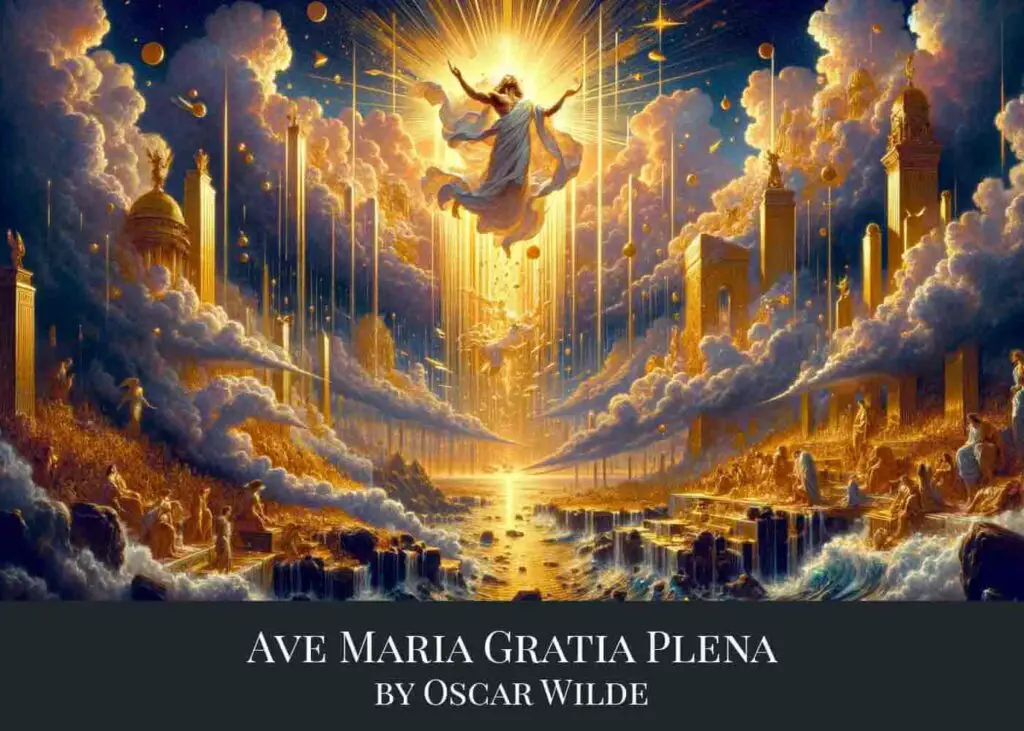
Ave Maria Gratia Plena by Oscar Wilde
“Ave Maria Gratia Plena” is a poem by writer, dramatist, and poet Oscar Wilde, showcasing his unique ability to weave together mythological and spiritual themes. This poem, included in Wilde’s poetry collection Poems, explores the profound and often unexpected nature of divine encounters. Wilde contrasts classical myths with Christian iconography, leading the reader through a journey of anticipation, disillusionment, and finally, a deep understanding of the divine. The imagery is rich and evocative, merging the human with the divine in a tapestry of emotion and revelation. For those interested in delving deeper into Wilde’s poetic genius, the Poems ebook is available for exploration at PageVio.
1. The Poem
Was this His coming! I had hoped to see
A scene of wondrous glory, as was told
Of some great God who in a rain of gold
Broke open bars and fell on Danae:
Or a dread vision as when Semele
Sickening for love and unappeased desire
Prayed to see God’s clear body, and the fire
Caught her brown limbs and slew her utterly:
With such glad dreams I sought this holy place,
And now with wondering eyes and heart I stand
Before this supreme mystery of Love:
Some kneeling girl with passionless pale face,
An angel with a lily in his hand,
And over both the white wings of a Dove.
Download Ave Maria Gratia Plena Poster
Size: 8″ x 12″ (2:3 ratio)
Format: PDF
Copyright information: For personal use only
Note: Actual poster background color is white. For the sample poster, the background is made gray for illustration purpose.
2. Ave Maria Gratia Plena Analysis
“Ave Maria Gratia Plena” reflects on the contrast between expectation and reality, specifically in the context of a divine or spiritual experience. The speaker recounts their anticipation of a grand, glorious manifestation of God, only to encounter a much more subdued and peaceful revelation. Let’s examine it stanza by stanza:
1. The first stanza expresses the speaker’s initial expectations of God’s coming. He hoped to witness an event of magnificent glory, reminiscent of mythological stories like the one where Zeus comes to Danae in a shower of gold, or the tragic tale of Semele, who desires to see Zeus’s true form and is destroyed by the sight. These references to Greek mythology suggest the speaker anticipated a dramatic, awe-inspiring divine appearance.
2. The second stanza reveals the speaker’s experience, which is starkly different from his expectations. Instead of a grandiose spectacle, the speaker finds himself in a “holy place” witnessing a scene of serene and gentle beauty. The “supreme mystery of Love” he encounters is not in overwhelming displays of power but in a simple, humble setting.
3. The final stanza describes the actual scene before the speaker: a kneeling girl with a “passionless pale face,” an angel holding a lily, symbolizing purity and innocence, and a dove overhead, often a symbol of the Holy Spirit in Christian iconography. This peaceful scene contrasts sharply with the dramatic images expected by the speaker.
The poem, therefore, explores the theme of divine revelation and the nature of spiritual experiences. It suggests that true encounters with the divine are not always as grand and overwhelming as one might expect; instead, they can be quiet, peaceful, and filled with a sense of deep, serene love. The speaker’s realization reflects a transformation from seeking spectacular signs to understanding the subtlety and gentleness of true spiritual revelation.
3. Conclusion
If “Ave Maria Gratia Plena” by Oscar Wilde, with its blend of mythic grandeur and spiritual profundity, has captivated you, delve deeper into the rich tapestry of other Wilde’s poetic works at Sevenov.